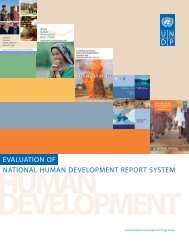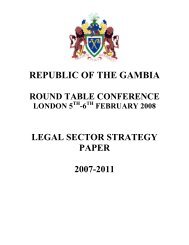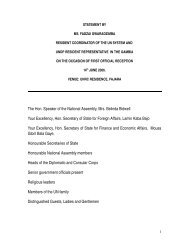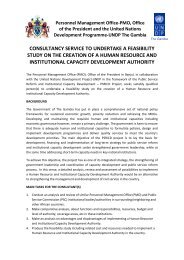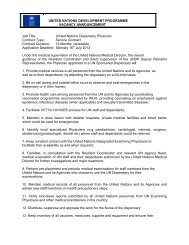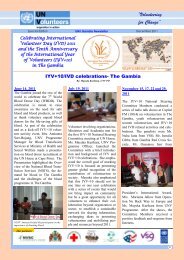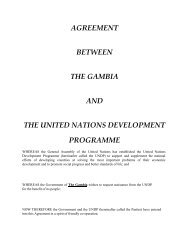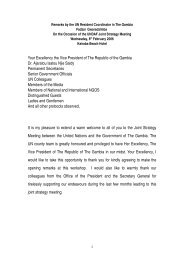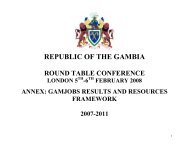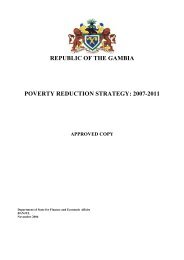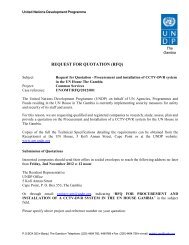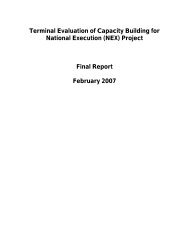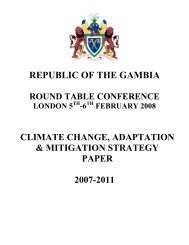Introduction - UNDP The Gambia
Introduction - UNDP The Gambia
Introduction - UNDP The Gambia
Create successful ePaper yourself
Turn your PDF publications into a flip-book with our unique Google optimized e-Paper software.
________________________________________________________________________________________________________________________<br />
of the country’s membership of the World<br />
Trade Organisation and the country’s<br />
eligibility under AGOA.<br />
DOSTIE is also being developed as a central<br />
information base for the private sector,<br />
especially for small producers like<br />
horticultural producers who need to be linked<br />
with consumers in the tourist industry, such<br />
as hotels and restaurants, and to overseas<br />
markets. It should be noted at this point that<br />
although some degree of success has been<br />
achieved in creating links between local<br />
producers and the hotel industry, this is<br />
largely limited to fresh vegetable and fresh<br />
fish supplies. Most other foodstuffs, such as<br />
meat, poultry and dairy products, are<br />
imported. Besides, these supplies to hotels are<br />
not always regular or consistent in the quality<br />
and quantity required by the tourist industry.<br />
In effect, the linkage between local producers<br />
and consumers in the tourist industry is still<br />
very weak.<br />
DOSTIE still lacks policy focus and the<br />
institutional capacity to effectively promote<br />
foreign investment for the growth and<br />
development of the manufacturing and<br />
processing industries, which are essential to<br />
expand the economic base of the country, for<br />
the creation of jobs, generation of income<br />
and, consequently, the reduction of poverty<br />
and the achievement of the other MDGs.<br />
<strong>The</strong>re are several constraints that inhibit the<br />
growth and development of the tourist<br />
industry in <strong>The</strong> <strong>Gambia</strong>, namely:<br />
• inadequate market expansion strategies<br />
• over-dependence on foreign tour<br />
operators for the promotion and<br />
marketing of <strong>The</strong> <strong>Gambia</strong> as a tourist<br />
destination<br />
• weak linkage between the tourist<br />
industry and local producers.<br />
<strong>The</strong> development of the tourist industry is<br />
hampered by the constraints of lack of<br />
adequate public institutional support, lack of<br />
effective policy support for growth in tourist<br />
arrivals and the burden of the multiple-tax<br />
regime and duties imposed on the private<br />
sector in the tourist industry, which act as a<br />
disincentive to the growth and sustainability<br />
of the industry.<br />
<strong>The</strong> seasonal nature of the tourist trade is also<br />
a major constraint to the growth and<br />
development of the industry. <strong>The</strong> tourist<br />
season is limited to five months of the year,<br />
namely, November to March.<br />
<strong>The</strong> current capacity building strategies at<br />
DOSTC, which are directed at assisting the<br />
growth and development of the tourist<br />
industry, are restricted in scope and will<br />
inevitably have a limited impact on the<br />
growth and development of the industry.<br />
3.3.2 Capacity Building at the<br />
Department of State for Tourism and<br />
Culture<br />
<strong>The</strong> tourist industry in <strong>The</strong> <strong>Gambia</strong>, although<br />
small in international terms (with annual<br />
visitor arrivals of some 100,000), is<br />
substantial as it averages a 12 percent share of<br />
the GDP and provides direct employment,<br />
including self-employment, to some 10,000<br />
people.<br />
Tourism is a substantial foreign exchange<br />
earner for the economy and therefore should<br />
be categorised as an export sector. It is also a<br />
substantial tax revenue earner for the<br />
government, and uses local agricultural<br />
produce.<br />
Capacity building components consist of<br />
strengthening the capacity of the <strong>Gambia</strong><br />
Tourism Authority (GTA) to market <strong>The</strong><br />
<strong>Gambia</strong> as a tourist destination in the<br />
international market, particularly in Europe. It<br />
also includes strengthening linkages between<br />
tourist industry consumers and local<br />
producers.<br />
It is evident from the multiplicity and<br />
complex nature of the constraints that beset<br />
the tourist industry that the above-cited<br />
strategies hardly address the needs of the<br />
sector. <strong>The</strong> GTA still lacks the institutional<br />
capacity and financial resources to afford a<br />
presence in the tourist emitting countries to<br />
promote the country as a competitive tourist<br />
destination. Its budget is inadequate to allow<br />
________________________________________________________________________________________________<br />
Building Capacity for the Attainment of the Millennium Development Goals in <strong>The</strong> <strong>Gambia</strong> National Human Development Report 2005<br />
33




